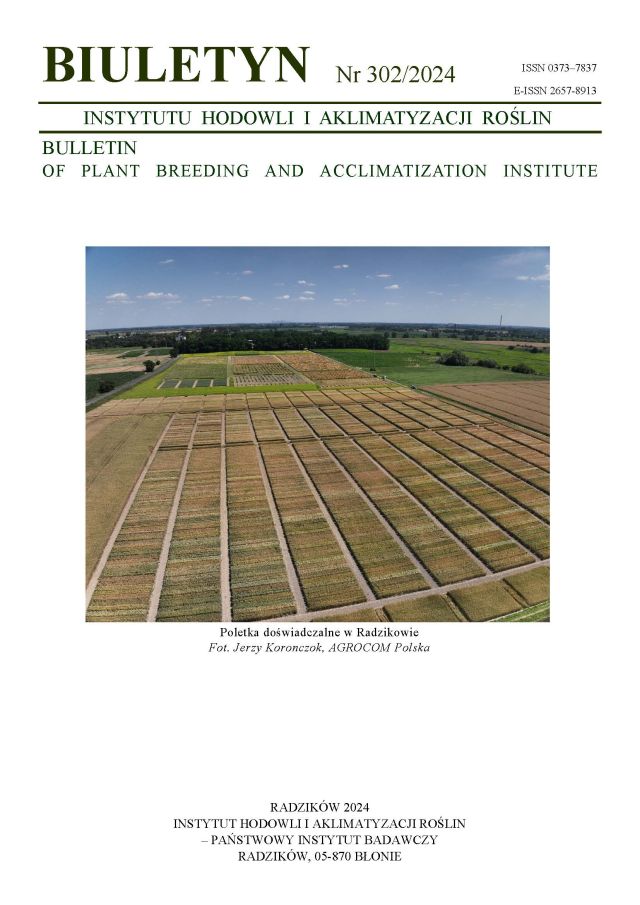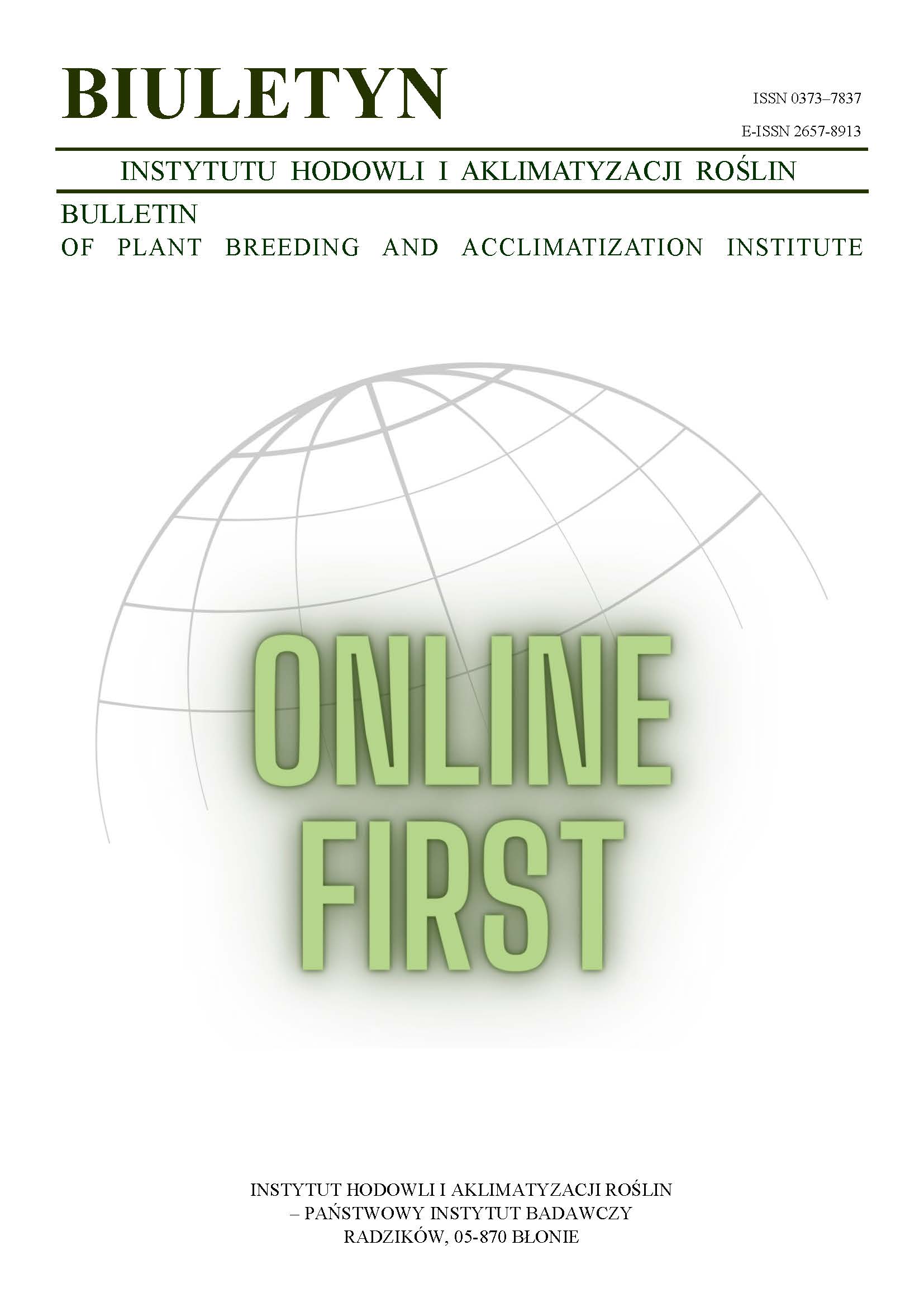Effects of nitrogen fertilization on grain yield, protein content and yield components of oats
Renata Tobiasz-Salach
ekpr@ur.edu.plKatedra Produkcji Roślinnej, Wydział Biologiczno-Rolniczy, Uniwersytet Rzeszowski, Rzeszów (Poland)
Dorota Bobrecka-Jamro
Katedra Produkcji Roślinnej, Wydział Biologiczno-Rolniczy, Uniwersytet Rzeszowski, Rzeszów (Poland)
Abstract
Test trials were carried out in the years 1988–2000 in order to determine the effects of N-fertilization on yield, its composition as well as protein and nitrogen content of grain of new cultivars of both naked and hulled oats. Positive growth responses to doses of nitrogen fertilization were observed. At the highest dose of nitrogen fertilization, of 90 kg·ha-1, the Sławko and Akt cultivars yielded 5.02 kg·ha-1 and 3.84 kg·ha-1 grain, respectively. The number of spikelets and weight of grains per panicle were mostly affected by the increasing nitrogen fertilization. The weight and number of 1000 grains, however, didn’t change with the fertilization increase.
Keywords:
nitrogen fertilization, naked oats, grain yield, yield components, total protein yieldReferences
Budzyński W. 1999. Reakcja odmian owsa na czynniki agrotechniczne, przegląd wyników badań krajowych. Żywność. Nauka. Technologia. Jakość. Supl. 1 (18): 11 — 25.
Google Scholar
Budzyński W., Wróbel E., Dubis B. 1999. Reakcja owsa nagiego na czynniki agrotechniczne. Żywność. Nauka. Technologia. Jakość. Supl. 1 (18): 97 — 103.
Google Scholar
Darwinkel A., Rops A, Wijnholds K. 1995. Nitrogen, seed rate and growth regulation in oats. Proefst. voor Akker. En. Groent. 188: 4 — 52.
Google Scholar
Fotyma E. 1988. Reakcja roślin uprawnych na nawożenie azotem. Cz. I. Zboża. Pam. Puł. 93: 37 — 59.
Google Scholar
Hołubowicz-Kliza G., Wierzbicka-Kukułowa A., Król M. 1991. Wpływ nawożenia azotem na plonowanie kilku odmian owsa na glebach kompleksów żytnich i zbożowo-pastewnych. W: Niektóre zagadnienia technologii uprawy owsa. IUNG Puławy R (275): 35 — 50.
Google Scholar
Kozłowska-Ptaszyńska Z., Pawłowska J., Woch J. 2000. Wpływ dawek azotu na plon i jego strukturę u nowych polskich odmian owsa. Biul. IHAR 215: 239 — 243.
Google Scholar
Mazurek J. 1993. Biologia i agrotechnika owsa. IUNG, Puławy.
Google Scholar
Mazurek J. Grabiński J. 1989. Produkcyjne wykorzystanie nawożenia azotem i plonowanie odmian zbóż jarych. Biul. IHAR 171/172: 273 — 276.
Google Scholar
Nawrocki S. Mazurek J. Król M. 1999. Produkcja zbóż na cele paszowe” Zesz. Probl. Post. Nauk Roln. 305: 101 — 118.
Google Scholar
Pawłowska J, Kozłowska-Ptaszyńska Z. 1999. Charakterystyka i technologia uprawy odmian owsa. IUNG, IHAR, COBORU, Puławy, Radzików, Słupia Wielka.
Google Scholar
Piech M., Nita Z., Maciorowski R. 2001. Reakcja owsa nieoplewionego i oplewionego na nawożenie azotem. Biul. IHAR 217: 111 — 119.
Google Scholar
Szukalska-Gołąb W. 1992. Możliwości zwiększania zawartości plonów białka zbóż. Post. Nauk Roln. 2: 57 — 67.
Google Scholar
Wróbel E. 1993. Wpływ nawożenia azotem na plonowanie i jakość białka ziarna jęczmienia jarego i owsa uprawianych na paszę. Acta Academiae Agriculture ac Technicae Olstenensis 58: 4 — 47.
Google Scholar
Wróbel E. 1989. Reakcja odmian owsa na poziom i termin stosowania azotu. Acta Academiae Agriculture ac Technicae Olstenensis 49: 119 — 125.
Google Scholar
Authors
Renata Tobiasz-Salachekpr@ur.edu.pl
Katedra Produkcji Roślinnej, Wydział Biologiczno-Rolniczy, Uniwersytet Rzeszowski, Rzeszów Poland
Authors
Dorota Bobrecka-JamroKatedra Produkcji Roślinnej, Wydział Biologiczno-Rolniczy, Uniwersytet Rzeszowski, Rzeszów Poland
Statistics
Abstract views: 27PDF downloads: 10
License
Copyright (c) 2006 Renata Tobiasz-Salach, Dorota Bobrecka-Jamro

This work is licensed under a Creative Commons Attribution-ShareAlike 4.0 International License.
Upon submitting the article, the Authors grant the Publisher a non-exclusive and free license to use the article for an indefinite period of time throughout the world in the following fields of use:
- Production and reproduction of copies of the article using a specific technique, including printing and digital technology.
- Placing on the market, lending or renting the original or copies of the article.
- Public performance, exhibition, display, reproduction, broadcasting and re-broadcasting, as well as making the article publicly available in such a way that everyone can access it at a place and time of their choice.
- Including the article in a collective work.
- Uploading an article in electronic form to electronic platforms or otherwise introducing an article in electronic form to the Internet or other network.
- Dissemination of the article in electronic form on the Internet or other network, in collective work as well as independently.
- Making the article available in an electronic version in such a way that everyone can access it at a place and time of their choice, in particular via the Internet.
Authors by sending a request for publication:
- They consent to the publication of the article in the journal,
- They agree to give the publication a DOI (Digital Object Identifier),
- They undertake to comply with the publishing house's code of ethics in accordance with the guidelines of the Committee on Publication Ethics (COPE), (http://ihar.edu.pl/biblioteka_i_wydawnictwa.php),
- They consent to the articles being made available in electronic form under the CC BY-SA 4.0 license, in open access,
- They agree to send article metadata to commercial and non-commercial journal indexing databases.
Most read articles by the same author(s)
- Marta Jańczak-Pieniążek, Jan Buczek, Renata Tobiasz-Salach, Dorota Bobrecka-Jamro, The impact of cultivation intensity for productivity on hybrid and population cultivars of winter wheat , Bulletin of Plant Breeding and Acclimatization Institute: No. 288 (2020): Regular issue
- Aneta Jarecka, Dorota Bobrecka-Jamro, Jan Buczek, Wacław Jarecki, Response of spring wheat to varied intensity of crop production technology , Bulletin of Plant Breeding and Acclimatization Institute: No. 287 (2019): Special issue
- Renata Tobiasz-Salach, Dorota Bobrecka-Jamro, Ewa Szpunar-Krok, Jan Buczek, Estimation of the economic value of hull-less oat cultivars grown in the Podkarpackie region , Bulletin of Plant Breeding and Acclimatization Institute: No. 244 (2007): Regular issue
- Jan Buczek, Ewa Szpunar-Krok, Renata Tobiasz-Salach, Dorota Bobrecka-Jamro, The effect of post-emergence herbicides on weed infestation and yielding of faba bean , Bulletin of Plant Breeding and Acclimatization Institute: No. 244 (2007): Regular issue
- Renata Tobiasz-Salach, Dorota Bobrecka-Jamro, Ewa Szpunar-Krok, Influence of foliar fertilization on yield and chemical composition of oat grain , Bulletin of Plant Breeding and Acclimatization Institute: No. 246 (2007): Regular issue
- Wacław Jarecki, Dorota Bobrecka-Jamro, Influence of different nitrogen doses on yielding of spring wheat , Bulletin of Plant Breeding and Acclimatization Institute: No. 265 (2012): Regular issue
- Wacław Jarecki, Dorota Bobrecka-Jamro, Reaction of spring wheat, Parabola variety, to leaf feeding with urea and Microcomplex , Bulletin of Plant Breeding and Acclimatization Institute: No. 262 (2011): Regular issue














